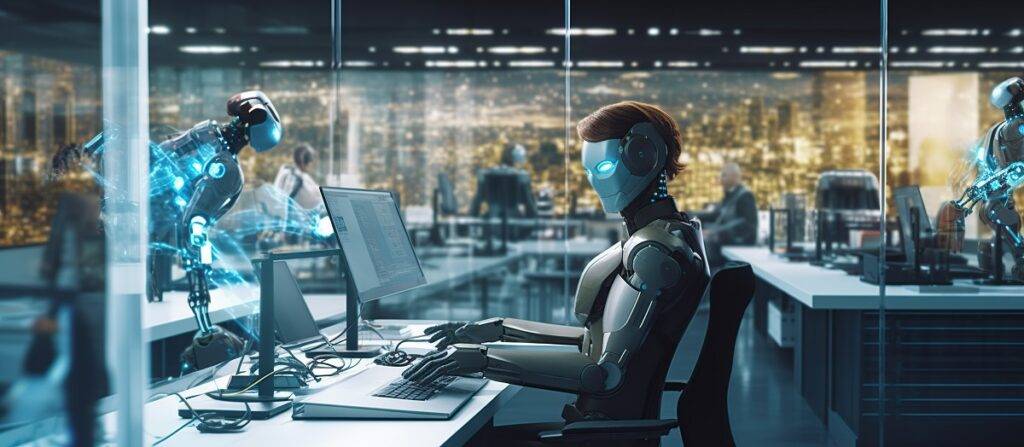The workplace landscape is undergoing a transformative shift as technology continues to advance, with Artificial Intelligence (AI) playing a pivotal role. Rather than being a threat to human employment, AI is increasingly becoming a collaborative partner, reshaping the way we work. In this exploration, we’ll delve into the evolving relationship between humans and AI in the workplace, highlighting collaborative approaches that leverage the strengths of both entities, fostering a harmonious and productive work environment.

The Evolution of Human-AI Collaboration
As we stand on the brink of 2024, the integration of AI into various industries is no longer a novelty; it’s a necessity. AI technologies, ranging from machine learning algorithms to natural language processing, have matured, enabling them to complement and enhance human capabilities. Rather than replacing jobs, AI is being employed to automate routine tasks, freeing up human workers to focus on more complex, creative, and strategic aspects of their roles.
The collaboration between humans and AI is evolving rapidly. Automation, once feared for its potential to replace jobs, is now seen as a means to augment human capabilities. Organizations are recognizing that a symbiotic relationship between humans and AI can lead to unprecedented levels of productivity and innovation.
Fostering Collaboration for Increased Productivity
- Task Automation for Efficiency: AI excels at repetitive and mundane tasks. By automating these routine processes, employees can redirect their efforts towards tasks that require critical thinking, problem-solving, and emotional intelligence. This not only boosts overall productivity but also enhances job satisfaction.
- Data-Driven Decision Making: AI systems process vast amounts of data at unprecedented speeds. Collaborating with AI in data analysis empowers humans to make more informed decisions. The synergy between human intuition and AI’s analytical prowess results in comprehensive insights that drive business strategies.
- Enhancing Creativity through Co-Creation: AI algorithms can analyze patterns and suggest innovative ideas. In fields such as design and content creation, human-AI collaboration brings a fresh perspective, combining the creativity of humans with the data-driven suggestions of AI, resulting in groundbreaking solutions.
As we explore the facets of collaboration, it’s essential to understand that the goal is not to replace human input with AI but to create a synergy where the strengths of each entity complement the other. The ideal collaboration is a dance between human intuition, emotional intelligence, and the analytical power and speed of AI.
Building a Harmonious Work Environment
- Continuous Learning and Adaptation: The rapid pace of technological advancement requires a workforce that is adaptable and continually updating its skill set. Collaborative efforts between humans and AI extend to training programs where AI systems assist in identifying skill gaps and providing personalized learning paths for employees.
- Addressing Ethical Considerations: Human-AI collaboration comes with ethical responsibilities. Organizations need to establish clear guidelines and frameworks to ensure that AI is deployed ethically and transparently. Collaboration should be founded on principles that prioritize fairness, accountability, and the well-being of individuals and society.
In this collaborative journey, continuous learning and adaptation are crucial. Training programs should be designed to upskill employees, ensuring they are equipped to work seamlessly with AI technologies. Ethical considerations must be at the forefront, with organizations actively ensuring that the integration of AI aligns with principles of fairness, accountability, and the well-being of both employees and society.
Challenges and Opportunities
- Overcoming Resistance and Fear: A key challenge in the integration of AI is overcoming resistance and fear among employees. Organizations must prioritize effective communication, providing clarity on how AI complements human roles rather than replacing them. This involves promoting a culture of learning and adaptation.
- Creating Inclusive Collaboration: To harness the full potential of human-AI collaboration, inclusivity is crucial. Employees at all levels should be involved in the integration process, ensuring that diverse perspectives contribute to the development and implementation of AI solutions.
The road to successful human-AI collaboration is not without its challenges. Overcoming resistance and fear among employees is a crucial step. Transparent communication about the role of AI in enhancing, not replacing, human capabilities is essential. Organizations should foster a culture of continuous learning to empower employees to adapt to the changing work landscape.
Navigating Ethical Considerations
As AI becomes more integrated into the fabric of the workplace, ethical considerations become paramount. Ensuring transparency in how AI algorithms function and make decisions is essential. Organizations should prioritize fairness and accountability, actively working to eliminate biases in AI systems. Additionally, there is a need for open dialogue about the ethical implications of AI, involving employees, stakeholders, and the wider community.
The Future Landscape of Work
Looking ahead to the remainder of 2024 and beyond, the collaborative relationship between humans and AI will continue to evolve. The workplace of the future will be characterized by a seamless integration of human and AI capabilities, with both entities playing unique and complementary roles. The emphasis will shift from fearing job displacement to creating opportunities for upskilling, reskilling, and embracing the collaborative potential of human-AI teams.
Conclusion
The year 2024 marks a significant juncture in the evolution of work, where humans and AI are not adversaries but collaborative partners. By embracing the strengths of both, organizations can create a work environment that is not only more efficient and productive but also fosters innovation and creativity. The key lies in understanding that the future of work is a collective effort, with humans and AI working together to redefine the possibilities of what can be achieved.
As we move forward, the successful integration of AI into the workplace requires a holistic approach. It’s not just about incorporating technology; it’s about building a culture that values collaboration, continuous learning, and ethical considerations. The future of work is collaborative, and it’s up to organizations and individuals alike to navigate this journey with openness, adaptability, and a shared vision of a harmonious and productive future.

